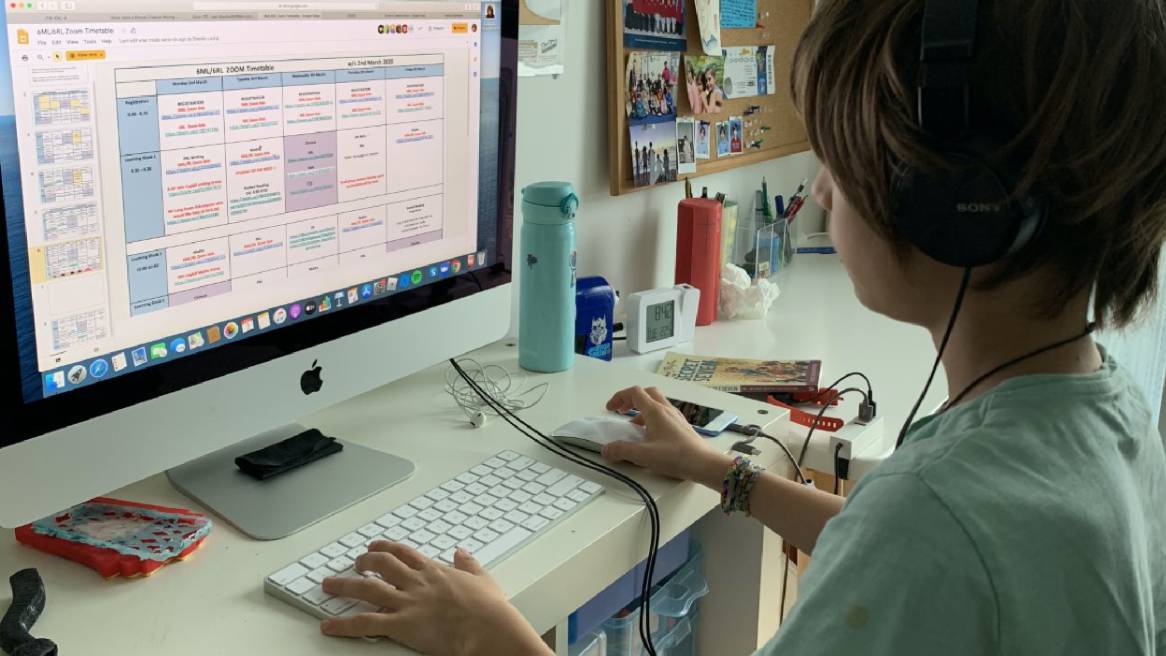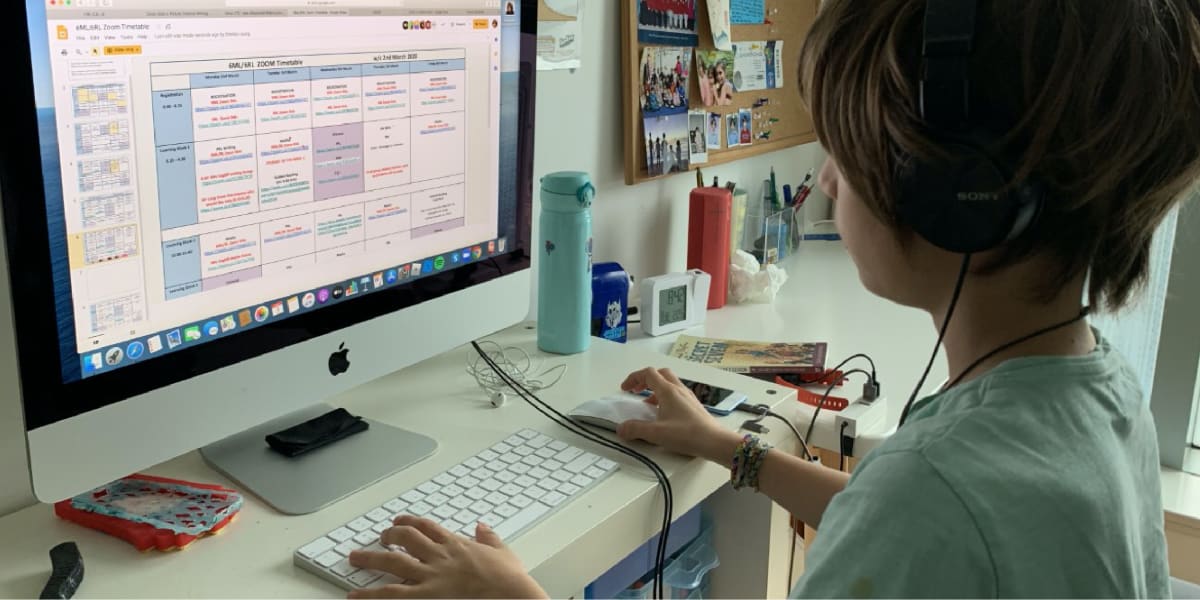This article is part of our Steelcase 360 series Making Distance Work about working remotely.
Hong Kong educators began the new year with a challenge: how to keep students engaged and learning at home, and largely online, during an extended school closure period. Due to public health concerns over the novel Coronavirus, schools have been closed since Chinese New Year for a period expected to be at least until 20 April. The unusual situation has become a springboard for innovation and creativity in adapting curriculum and lesson delivery, particularly for middle and high school students, so that they can continue learning without disruption. While every community and school is different, there are many lessons from Hong Kong that educators around the world can use, should they need to support remote learning.
Making Active Learning Virtual
The closure of schools isn’t entirely unprecedented – typhoons and other public disruptions have prompted the move previously, and at the Hong Kong International School (HKIS), events in late 2019 saw educators dip a toe in the water of the virtual environment.
HKIS associate principal for teaching and learning, Brent Brayko, says the school, which caters for students in Grades 9-12, was already using an online learning management system to distribute schedules, make resources accessible and submit assignments online. While this provided a foundation for online education, other elements were required to make learning as active and successful as possible.
“We learned there needed to be some accountability for students so the teachers knew they were online, and there was a time every day during class to touch base. That human contact, even though
it is virtual, is still important”
Brent Brayko
Associate Principal, Hong Kong International School
This insight is supported by Steelcase research, outlined in the Blended Learning Ideabook, which found that blended learning works best when it combines online and face-to-face activities. Ordinarily, an optimal approach will combine web-based, mobile and classroom-based technologies. This combination improves learning effectiveness by allowing for individually-tailored content, pace and feedback; provides access to diverse, outside-the-classroom content and experts; and enables peer-to-peer and group learning. Given that this ideal scenario of person-to-person connection is not currently possible, educators are looking for other ways to bring these elements into the virtual classroom.
Victor d’Hauteville, an 11-year-old student in Hong Kong, says his online maths lessons have been almost like a normal school day. The class commences with the teacher explaining concepts and tasks, answering questions, through the video platform, Zoom. The students are then assigned some individual exercises to work through with a specified submission time, to ‘hand in’ work via Google Drive. Project-based learning activities enable students to work in pairs. Victor and a classmate use WeChat video to collaborate on a research project together.
At HKIS, teachers have been using Zoom to conduct online lessons either from home or their usual classrooms. The videoconferencing platform lets teachers see and interact with students in lecture, Q+A and discussion formats while also offering the chance for teachers to divide the class into breakout ‘rooms’ for smaller group work and interactions.
Though nothing can replace the experience of being together in person, being able to use video conference, rather than just attend a voice call, improves the quality of virtual interactions considerably.
A 2014 Fuzebox survey found that 80% of the messages people receive come from body language, and according to the article, ‘Making Distance Disappear’, in Steelcase 360 Magazine, making eye contact switches on parts of the brain called mirror neurons, which enable us to ‘read’ other people’s intentions, building mutual understanding and empathy.
“Those extra tools have made interaction and feedback more efficient, because that’s important in this virtual learning environment. It can make the difference between an information “dump” and being an information curator. It’s very easy to just put a bunch of material online, but we need to teach,” Brayko says.
Personalising Learning
While technology can certainly provide connection between teachers and students, one of the challenges, says Sarah Wheatley, a high school humanities teacher at HKIS, is adapting course content to a teaching mode that is less interactive by nature.
“So much of my course is based on class discussion, and how do you replicate that?” she asks. “What I figured out is you can’t quite replace it, though we can have online written chats or Zoom chats,” says Wheatley.
To achieve their learning objectives, teachers need to be far more creative in the way they plan lesson delivery. For example, music teachers film videos to teach students how to make musical instruments from household items, or ask students to practise a song and record themselves singing.
One of the advantages of utilising technology in education, according to Steelcase research, is that it can supplement face-to-face interactions with access to the enormous repository of knowledge available online. Teachers and students can then spend class time focusing on higher-level cognitive learning with rich discussion and more dynamic, active interaction.
Wheatley augments her online lessons by providing interactive learning tools for students to follow up after the lesson, including Google slides with links to further information, such as definitions for new vocabulary words.
“We’re flexing a lot of our creative muscles right now, but making it fun.”
Sarah Wheatley
Humanities Teacher, Hong Kong International School
A Holistic Approach
Having students spend eight hours of each day in front of a screen, isolated from their peers, is obviously an undesirable scenario, so educators are thinking deeply about how they can manage the social, emotional and physical wellbeing of students.
Teachers in areas of the curriculum such as physical education are getting kids active by setting activities such as going for a run and documenting what they see on the way; providing a yoga routine to complete, and then taking photos of themselves in the poses; or in the case of Victor’s class, teaching students how to juggle.
This lateral thinking is extending to subjects that lend themselves less obviously to physical activity. Wheatley has provided novels by mail so that when possible, her students can read a physical book rather than a screen, and has designed a lesson around a podcast – which students could listen to while on a walk – with a follow-up discussion planned for ‘class time’.
HKIS has also brought its wellbeing check-in system online, so that school counsellors can continue to touch base with students via video calls. And importantly, school hours have typically been shortened to allow for more outdoor activities and more family time to try to compensate for the valuable interpersonal interaction that ordinarily happens in the school environment.
21st Century Skills
Fostering essential skills such as creativity, curiosity and collaboration – for both students and teachers – is an unexpected benefit of what is an extremely disruptive scenario, Steelcase WorkSpace Futures Senior Design Researcher Aileen Strickland-McGee explains.
“Because this is a new situation and nobody has all the answers, people seem more apt to see the possibilities of the situation, rather than the limitations. Creativity happens not just when there is an open, blank canvas, but when new constraints force ingenuity and innovation. So, this new situation is a fertile ground for adaptability, agility and creativity to be practised and flourish,” says Strickland-McGee.
It has also provided the opportunity for students to learn accountability and take responsibility for their own learning while operating autonomously.
Steelcase research on personalised learning has found that when students are extended trust to take responsibility for themselves and their learning, they generally step up, which not only builds these traits but also nurtures a sense of trust with their parents and teachers. “By understanding how students behave when given freedom, teachers can adapt their approach and respond to learner needs and interests”, says Steelcase WorkSpace Futures Manager, Andrew Kim. This has certainly been the case at HKIS. Brayko reports that attendance has been strong, even for students who remain overseas in different time zones, many of whom are still attending the virtual classes. Students can access course materials easily and teachers are proactive in following up to check on any students who are not participating in class or completing work.
“By understanding how students behave when given freedom, teachers can adapt their approach and respond to learner needs and interests.”
Andrew Kim
Manager, WorkSpace Futures
Virtual school: Tips for teachers
Educators admit it can be a steep learning curve to make a rapid transition from being primarily classroom-based to adopting a blended learning approach, but collaboration and communication are key – both internally within the school and with colleagues in other schools, who may share experiences, ideas and policies.
Again, technology can be an enabler of information exchange – at HKIS, a tech expert has been upskilling fellow faculty members with tips and tricks on the platforms and applications they are using, while a shared Google doc allows all teachers to post helpful finds and workarounds to accelerate the process of adapting their lessons. While it’s not quite the same as being able to ask a colleague a quick question in the staff room, other tools such as Google hangouts and WhatsApp groups can facilitate communication.
Advice for parents supporting students
- Create a personalised space for learning. Home is a place that we look to for inspiration in learning environments, for comfort and a sense of belonging. Soft lighting, a comfortable upholstered chair, a favourite photo or books on display, or a warm, cozy blanket – elements of home create personalised learning environments where students feel a sense of ownership. Also consider access to power; ability to change posture and move throughout the day; some access to privacy for focus where possible; and proximity to work tools, other people at home and refreshments.
- Try to establish a dedicated – or at least regular – space in the home for students to do their virtual learning, even if it is a corner of the kitchen table. “It might be helpful to say, ‘This area is where school happens’ – there is something psychological about that routine,” Brayko says.
- Routine is important. Ask children at home what their schedule of classes is, from checking attendance in the morning and through the day. Particularly as some schools have rotating schedules, this is one way parents or caregivers can help children ensure they are organised.
- Take advantage of breaks in the day such as free periods, and before and after school hours to replace the physical activity and social interaction they are missing while not with their peers: active family outings such as going on a walk or a hike, or going out for a meal together, can give their mental wellbeing a boost.
- Keep checking in with your child about how they are doing, and encourage them to take any concerns or frustrations to their teachers so they can be resolved.
For the short term, as school in Hong Kong remains online, there will continue to be opportunities to explore creativity and build student resilience and responsibility.
And while Wheatley has been impressed by her students’ commitment in this new way of learning, she is looking forward to returning to regular school: “The best part of my job is interacting with my students in the classrooms and having that relationship. I really miss the face-to-face time with them and my colleagues.”



